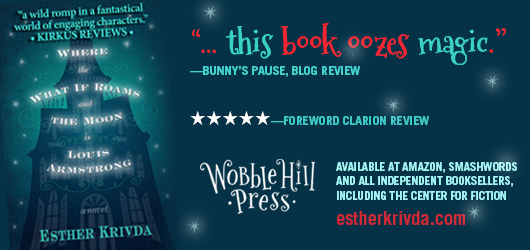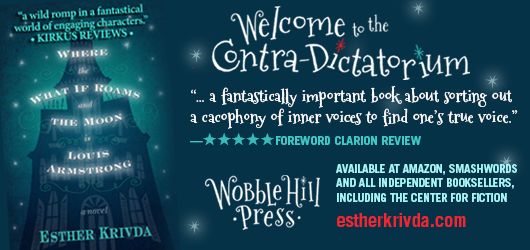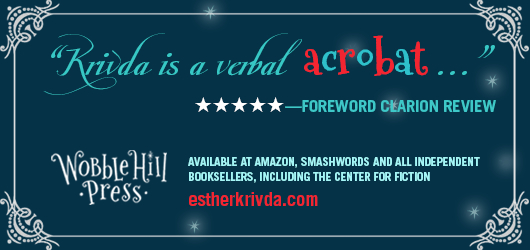A Modern Psychological Fairy Tale-An Interview with Esther Krivda, author of Where the What If Roams and the Moon is Louis Armstrong
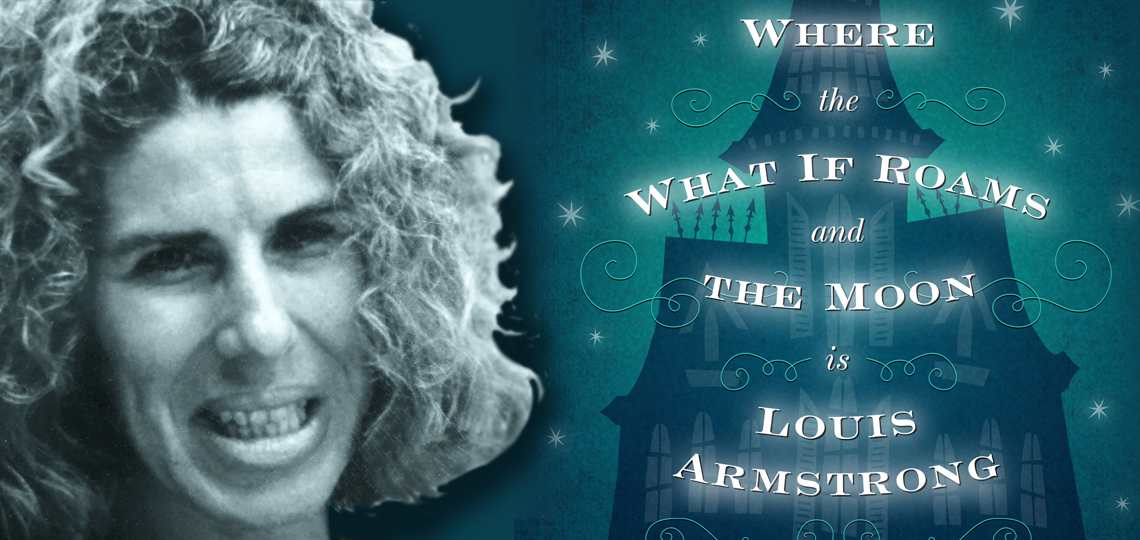
Is there anything so complex and contradictory as the human mind? We endlessly question, hope, 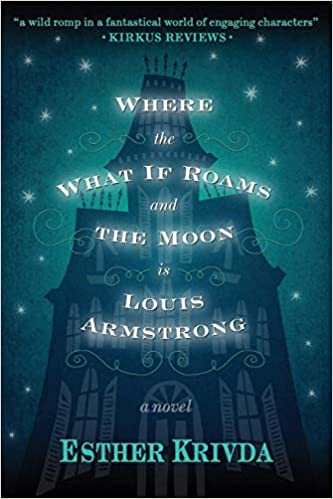
dream, and create. We continually challenge ourselves to reach for the stars, and yet often miss the forest for the trees. Human beings are an incalculable variable, our capacity for growth and change hindered only by our self-imposed limitations. What could we achieve if only we stopped listening to those little voices in our heads that tell us it can’t be done?
Esther Krivda cracks the door open to that world of possibilities in her debut novel, Where the What If Roams and the Moon Is Louis Armstrong, a self-described “modern psychological fairy tale” about a young girl who rarely speaks, but dreams of becoming a movie star—if she can quiet the fairies in her head.
In his five-star Clarion review, Scott Neuffer called it “an expansive, effusive, and fluidly stylish young adult work … about sorting out a cacophony of inner voices to find one’s true voice.” We were compelled to agree, and set up an interview with Esther to hear more about the crafting of this intricate novel.
Over to you, Esther!
This is such a whimsical, fantastical, and wholly unique novel, it seems it could only have sprung from a dream. From where did your inspiration arise?
I so hoped to tell a whimsical, fantastical, unique story. Thank you. And yes, creatures roam my novel who might only be found in dreams. But then creatures in the guise of voices sound off in me. My mother’s dire warnings. An old teacher’s harping. My brother’s teasing.
I’d often wonder, how am I expected to proceed if there’s a vast chorus inside me opining on my every move? That chorus takes up such valuable real estate in my head, though their owners are long gone. Yet, these interlopers can be helpful, but some of them can be pretty darn bossy too. Am I really supposed to be a multiverse—a little bit of me, and a whole lot of others? Where do I begin and they end? And who’s really in control?
And that’s what I explore in this novel. However, the difference between my life and my novel is, in my novel, I give those invisible head-squatters walk-on, visible (at least, to the reader) parts. There’s the What If, that atomic-sized agitator, in Father Oomla’s head; the crooner in Mother Oomla’s; and those fairies in Sophia Oomla’s, our young protagonist. So who’s in control? The Oomlas? Or those head-squatters?
You utilize a creative narration strategy with your debut novel, including using yourself, the author, as the narrator while other characters fight the protagonist for center stage. How did you settle on this technique?
My story is really about the mind. So I’ve placed myself in the story to represent those wise forces within ourselves, within our minds, that sort it all out. Let me explain.
And stop your snickering.
The Oomlas certainly have their own thoughts that arise from their unique selves. But they also have within them phantoms that seem to be their own thoughts but actually are not. If they listened carefully, they’d hear their parents. They’d hear all sorts of mental companions, like a boss they fear, or a movie star they compare themselves to. And certainly emotions, especially guilt, are in there, too, competing for control. And let’s not forget about those invisible pests who gleefully offer up their two cents. Who exactly is in the Oomlas’ driver’s seats? Is it their guilt, their overbearing father, their authentic self, or those pesky phantoms? What will help them figure that out? Intelligence, insight, understanding, unquestionably. All of which are in a mind.
Enter yours truly. Your wise, all-knowing author.
Hah.
Sort it all out? What, pray tell, was I thinking? For example, my attempt to sort out the fairies was, I hereby publicly admit, pathetic. I kept making them face facts and they kept giving me lip because pesky fairies and mouthy tricksters have, speaking of minds, minds of their own. As if anybody can control a mind!
From Shakespeare to Dickens to Swift, plenty of authors are alluded to within the novel. What are some of your favorite authors or works? Did they influence you at all in writing?
Writers, of course, use words to describe the world and its people. How a writer puts them to work is their signature. However, what Dickens does with them is, or should be, the envy of all wordsmiths! They charm, blush, clown, strut, preach, finagle, cheat, scheme, swindle, and swagger about the page to only lie grief-stricken on it a few paragraphs later. Any other scribbler would be arrested for indecent disclosure. But words under his pen can make a reader finally understand something, or see someone so vividly that there they stand, speaking, maybe even stinking, right in front of him, though our reader is off sitting by himself with a mere book in his hand. And that’s how Dickens keeps readers in their seats. He entertains like a bumbling tumbler so that readers will stick around to find out what he really wants them to know. That, along with love and luck, there’s also cruelty and injustice and absurdity in our world. And he wants you to feel all of it as if it’s happening to you.
So, when I wrote about Mrs. Oomla’s corporation, Giggle, and Dr. Oomla’s Institute, I wanted to show the injustices in their world (and our world) by using Dickens’ types of words. I wanted my words to clown and strut and to bear witness so that my readers will feel those injustices as if they were happening to them.
I am so flattered that you see Swift in my novel. My intention was to satirize Giggle Inc., Mrs. Oomla’s corporation, where she is the CEO. But I never imagined that I could write anything near his level of satire.
My What If character, however, comes from the land of Lewis Carroll. Well, at least, I like to think that he might come up with something like a What If. An idea, a concept, but one that comes to life in the form of an actual, atomic-sized mischief-maker who can do the things that embody his name. The What If plays an important role in my novel since he is one of the invisible forces who’s trying to call one of my characters’ shots. The concept of an invisible force trying to control us is a central theme of my novel. In fact, it’s so central to it, his name gets top billing in the title.
And, concerning Shakespeare, yours truly will never occupy his stratosphere, but someday she does wish to come up with something remotely equivalent to “your chin double, your wit single.”
While Sophia has trouble talking to her friends and teachers, she has quite a rapport with the man in the moon. As a child did you have any similar “imaginary” friends—lunar or otherwise?
You’ve made me stop and think. I can’t say I remember having an imaginary friend. Although when I was young, I was always reading fiction. So since it was fiction, couldn’t the characters in those stories be considered imaginary? But did I talk to them? I wonder…
About the man in my moon—Louis Armstrong seems to me to have been such a kind, caring, wise human being, I couldn’t have cast a better person for the role of Sophia’s angel. And because he really observed and listened to her, he, and not her mother or her father or her nanny or her teacher, understands her reluctance to talk. It’s him who gets her to open up. Sometimes we actually do meet the right person at the right time. He appears exactly when Sophia needs him.
Elements of your personal history—acting, working in a talent agency, etc.—feature prominently in the book, primarily through Sophia and her mother. Are any of their circumstances or struggles pulled from personal experiences?
I acted when I was young and have always identified with actors. And for several of my working years, I was employed as an office worker in the entertainment business— a cable television network, the movie studios in Los Angeles, a talent agency in New York City and, for six weeks, a Broadway producer. I watched shows and movies and plays as they were put together from start to finish. I worked with the above-the-line people (the talent, aka “Royalty”), the below-the-line people (talented too, alas “Not Stars”) and the back-office people, (way in the back, the gophers, the wannabes, the “Who the #@!! Are You?“s) and it opened my eyes to, as Zorba the Greek would say, “the full catastrophe.” And boy! Do I have material! Juicy. Hysterical. And some (fortunately for this storyteller) just as Zorba called it. Show business fascinates me. I watch a movie or a play or a news show and I’m spinning imaginary dramas, not about the story they’re telling but about the actors and the directors, and even the supernumeraries in the drama I’m watching. I see the crew, the talent, the sets, and what I see is intrigue brewing, and that, to me, is where the real drama is. Not on the stage at all. Are your ears burning? I hope so!
Finally, do you have any other projects in the works at the moment you can talk about?
I have two. The first one is a novel. Again with the entertainment business as a backdrop, but this time it involves a newsroom and a twenty-two-year-old intern.
The next project is a storybook about a mouse and a little girl.
The story I will write. The pictures I will draw.
I can draw, though I am seriously, and I do not exaggerate, rusty. Which has made it a Mt. Everest. But then, aren’t all artistic endeavors? Except this one is just a few inches higher. Since I’m determined to tell AND show this story, I may have to practice drawing a hundred more years before I can pull it off.
But the story I will write. And the pictures I will draw.
Well, you’ll always know where to find me.
Where the What if Roams and the Moon is Louis Armstrong
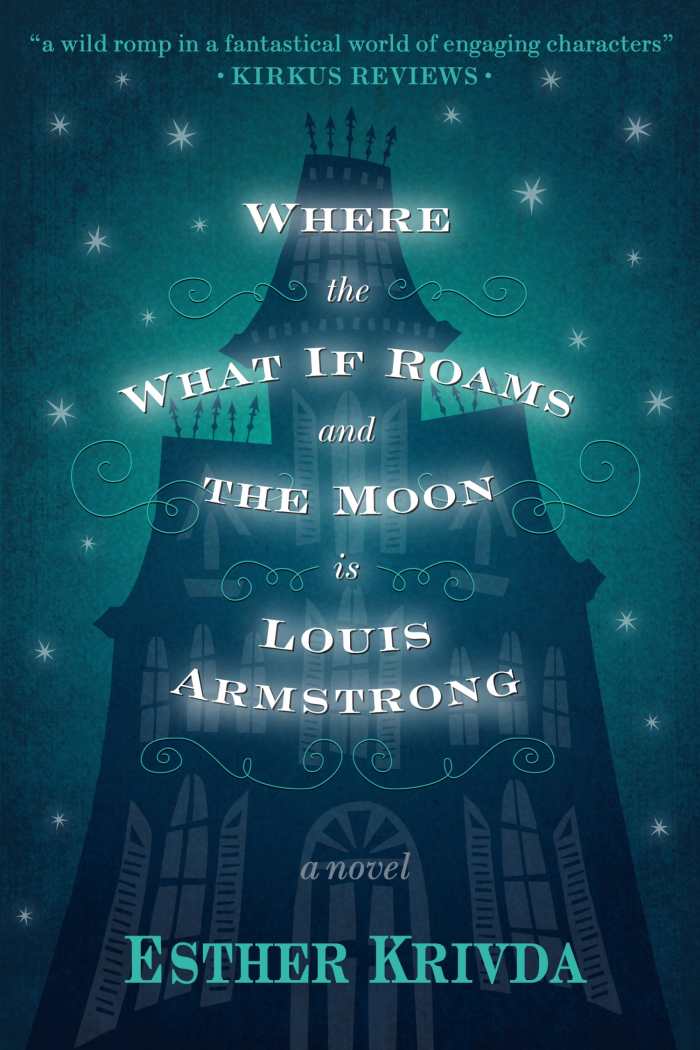
Esther Krivda
Wobble Hill Press
Softcover $19.99 (668pp)
978-0-9975892-0-7
Buy: Local Bookstore (Bookshop)
Krivda delivers an expansive, effusive, and fluidly stylish young adult work full of quirky energy and multigenerational appeal.
Esther Krivda’s debut novel, Where the What If Roams and the Moon Is Louis Armstrong, is a special kind of book, the kind of book that warrants many readings and a future CliffsNotes edition. It is a long, heady emporium of a book. Krivda herself describes it as a modern psychological fairy tale. Indeed, there are fairies in this book. But her own description almost belies, or at least oversimplifies, the ambitious nature of this marvelous and virtuosic work. This is the kind of book that scares off publishers, intimidates readers, and announces a major literary talent.
Where the What If Roams alludes to both William Shakespeare’s A Midsummer Night’s Dream and Jonathan Swift’s Gulliver’s Travels. Krivda borrows from both. Dueling narrators, a self-aware author, and a rambunctious band of fairies constantly bicker and interrupt each other in the retelling of the central narrative, which revolves around a ten-year-old girl named Sophia Oomla, who, though she has trouble speaking, dreams of becoming a movie star.
Swiftian satire is at work in the parallel stories of Sophia’s parents: her mother, Sigrid, who works in the New York–like city of Goliathon as CEO of Giggle, Inc., and her father, Sigmund, who works as a Freudian psychoanalyst in the Institute, a mental hospital treating distressed movie stars, or “Artistes.” The plot focuses on one pivotal week in the lives of these and supporting characters, and Krivda uses italics to break out their polyphonic inner thoughts.
The author’s technique doesn’t so much produce stream-of-consciousness as it does rivers-of-consciousness. The writing is expansive, effusive, fluidly stylish, and full of quirky energy. Krivda unleashes multiple modifiers in her longer constructions, “her sparkly, coaxy, tickly, with-a-cherry-on-top voice,” and shorter fragments in moments of dramatic tension: “She waited. And waited. Somebody was coming. Somebody. Was.” This variety in construction, combined with an ample vocabulary and a propensity for neologisms like “CEOing,” create an overall musical experience. Krivda is a verbal acrobat performing the rhythms of her imagination across the page: cartwheeling, dancing, pirouetting when needed.
Yet her playful loquaciousness doesn’t preclude moments of plaintive realism. Getting to the heart of her characters, Krivda’s wording and tone shift the way a magician’s cape shifts, revealing some sad and indelible reality of the human condition: “And he felt every inch of that vast, friendless space. He could have used some human companions. And a real hero. And not a room full of fancy. And a mind full of guilt.”
Though Krivda describes the novel as a “crossover” for both young readers and adults, it might be too challenging for early teen readers. But for older teens, and for adults especially, this is a fantastically important book about sorting out a cacophony of inner voices to find one’s true voice. As Louis Armstrong, appearing as the Man in the Moon, reminds us toward the end of the book, “There never’ll be another sound like the sound of you.”
SCOTT NEUFFER (November 8, 2019)
Barbara Hodge

